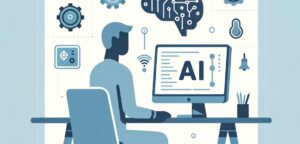AI is about making smarter applications that improve user experience and functionality. From automating tedious tasks to enhancing software testing and maintenance, AI is a key player in modern software practices.
If you want to learn more about AI, check out this article on how to create generative AI models. It explains what Generative AI can do, examines how it changes different industries, and gives tips for building AI solutions.
Let’s get started!
AI Concepts in Software Development
In software development, AI allows applications to perform complex tasks that traditionally required human intelligence. Two key AI concepts are machine learning (ML) and natural language processing (NLP):
Machine Learning (ML)
ML algorithms enable software to learn from and make predictions or decisions based on data. In software development, ML is used for various tasks such as data analysis, pattern recognition, and automation. For instance, ML algorithms can be trained to classify images, predict user behavior, or detect anomalies in data.
Natural Language Processing (NLP)
NLP focuses on enabling computers to understand, interpret, and generate human language. In software development, NLP is used for applications like chatbots, sentiment analysis, and language translation.
Moreover, you can read the article on integrating AI into mobile applications to see how AI can significantly enhance apps’ capabilities and user experience. You will also find out a step-by-step AI integration guide and expert tips!
Ways to Integrate AI in Software Development
Artificial Intelligence can change the way software is developed, tested, and maintained. Here are some key areas where AI is making a significant impact:
AI-powered code generation
AI-driven tools like GitHub’s Copilot use machine learning models trained on vast codebases to suggest and generate code snippets. This reduces errors and allows developers to focus on more complex problems. For instance, OpenAI’s Codex powers Copilot and facilitates coding in multiple languages.
Software testing with AI
AI improves software testing by automating test case generation and identifying potential bugs that are difficult for human testers to catch. Tools like Testim and Applitools use AI to optimize testing workflows and improve the accuracy of tests, leading to higher software quality. For instance, Diffblue uses AI to automatically write tests for Java code, ensuring that every function is checked for errors, thus saving time and enhancing code reliability.
Predictive analytics in software development
Predictive analytics in software development leverages AI to extract actionable insights from data, allowing developers to anticipate user behaviors and system demands. For example, by using tools like Microsoft’s Azure Machine Learning, developers can analyze usage patterns to predict peak loads, enabling preemptive scaling of resources to maintain performance. It helps in resource optimization, reducing operational costs.
Moreover, by predicting feature popularity, teams can prioritize development efforts accordingly and ensure that the most valued functionalities are refined and delivered first.
AI-driven project management
AI-driven project management transforms traditional approaches by automating task allocation and optimizing resource management. For instance, tools like Asana integrate AI to forecast project timelines and identify potential bottlenecks before they disrupt workflow. This not only helps teams stay on schedule but also improves decision-making with real-time data insights.
In addition, AI can prioritize tasks based on urgency and complexity, ensuring that critical issues are addressed promptly. By integrating AI, project managers can focus more on strategic planning and less on day-to-day operations, boosting overall productivity and project success.
AI for software maintenance and updates
AI automates routine tasks such as monitoring, debugging, and patching. For example, OverOps use AI to detect and diagnose critical software errors in real-time, often before they impact the end user. This maintenance can greatly reduce downtime and improve application stability.
AI also helps in managing dependencies more efficiently, automatically suggesting updates that keep the software secure and performing optimally.
Considerations in AI Implementation
Implementing AI in business processes or products requires careful consideration of several key aspects. Addressing these considerations is crucial not only to leverage AI effectively but also to make sure it contributes positively to society and operates within ethical boundaries.
Here are 3 aspects to take into account:
Ethical considerations and biases
Addressing ethical considerations and potential biases in AI applications is essential to ensure fairness and inclusivity. AI systems can unintentionally perpetuate existing social biases if they are trained on unrepresentative or prejudiced data.
For example, facial recognition technologies have faced criticism for higher error rates with certain demographics. To combat this, it’s important to use balanced datasets and employ bias detection methodologies during the AI development cycle. Regular ethical audits and involving diverse teams in AI projects can also help in identifying and mitigating biases effectively, ensuring that AI systems serve all user groups equitably.
Skill gap and training
The skill gap in AI requires targeted education and practical training strategies. As AI technology advances, professionals need to stay updated with the latest tools and methodologies. Companies can foster the development by offering workshops, courses, and hands-on projects that focus on AI literacy and application.
For instance, creating internal AI learning tracks or partnering with educational platforms like Coursera or Udacity can provide employees with the necessary skills.
Data privacy and security
As AI systems often process large volumes of sensitive data, adopting advanced encryption methods and regular security audits can safeguard against breaches. For example, using techniques like federated learning can help minimize risks by analyzing data locally on users’ devices rather than transferring it to central servers.
It’s also crucial to comply with international standards and regulations, such as GDPR in Europe, which emphasize transparency and user consent in data usage.
Conclusion
AI has massive potential for innovation and efficiency. By automating routine tasks, boosting accuracy, and driving smarter decision-making, AI technologies are not just optional but essential for staying competitive.
Embracing AI tools and methodologies can transform your development processes and lead to innovative products and services. Integrate AI into your software practices to foster innovation and carve out a significant competitive advantage!




0 Comments